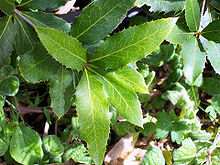에이도테아
Eidothea| 에이도테아 | |
|---|---|
 | |
| 에이도테아강화아나속 | |
| 과학적 분류 | |
| 킹덤: | 플랜태 |
| 클래드: | 기관지동물 |
| 클래드: | 안기오스페름스 |
| 클래드: | 에우디코츠 |
| 순서: | 프로테아목 |
| 패밀리: | 프로테아과 |
| 하위 패밀리: | 프로테오아이데아과 |
| 속: | 에이도테아 A.W. 더글라스 & B.하이랜드[1][2][3] |
| 종류종 | |
| 아이도테아조엑실로카리아속 | |
| 종 | |
| 텍스트 보기 | |
에이도테아는 오스트레일리아 동부의 뉴사우스웨일스와 퀸즐랜드에 있는 두 종의 열대우림 나무의 속성으로, 프로테아과 식물과의 일부를 이루고 있다.[1][2][4]프로테아과 식물과는 그리스 신화의 변형신 프로테우스의 이름을 따서 명명되었다.속명 '에이다테아'는 프로테우스의 세 딸 중 한 명을 가리킨다.[5]
1883년 독일-호주 식물학자 페르디난드 폰 뮐러는 빅토리아에 있는 오래된 금광 채굴장에서 발굴된 미오세 시대 퇴적물에서 화석 씨앗을 실로카리온 록키라고 명명했다; 그것들은 에이도테아의 그것과 일치하고 현대 식물을 대표하는 것으로 생각된다.[6][7]
Eidothea 지리적 영역 이상 1000km(620mi)으로 분리된에서 알려져 있으므로, 젖은 열대 지방 동북부 퀸스 랜드 주 북동쪽 뉴 사우스 웨일즈의 나이트캡 산맥 지역의 남부와 빅토리아의 화석, 남south,[2][8]한 중은 호주의 열대 우림은 작은 잔해들을 강조하기로 산에 간다.cient수백만년 전에 호주의 넓은 지역을 덮었던 열대우림.이것은 그들을 호주의 자연유산의 특히 소중한 한 부분으로 만든다.
분류학
프로테아과에는 또한 와라타, 그레빌라, 뱅크시아, 마카다미아, 프로테아 등 더 잘 알려진 구성원들이 포함되어 있다.프로테아과(Proteaea)는 고대 곤드와나의 초대륙이 아직 갈라지지 않은 상태에서 유래한 꽃식물들의 매우 오래된 계열이다.곤드와나는 현재 호주, 아프리카, 남미, 남극 대륙과 뉴질랜드, 뉴칼레도니아, 마다가스카르 같은 작은 조각과 조각들로 구성되었다.곤드와나는 1억 2천만년 전에 갈라지기 시작했고 조각들은 프로테아과의 다양한 선들을 포함하여 다양한 식물과 동물들을 가지고 있었다.Eidothea는 호주 동부의 열대우림에서 간신히 살아남은 초기 라인 중 한 곳의 유일한 유물이다.다른 라인업들은 눈부시게 다양화하여 수백 종의 후손들이 생겨났다.[8][9]
Eidothea lies within the subfamily Proteoideae, which contain such plants as Protea, Leucadendron, Leucospermum, and most other South African Proteaceae, Isopogon (Australian ‘drumsticks’), Adenanthos (Australian jugflowers), Petrophile (Australian ‘conesticks’), Conospermum (Australian smoke-bushes).[2][8][9]
종
두 가지 생물종이 알려져 있다.
- Eidothea hardiiana - Nightcap 국립공원과 인접한 Whian State Forest에서만 알려진 자연발생이며, 1995년 New South Walese 위협종 보호법 부칙 1에 멸종위기종으로 등재되었다.
- Eidothea zoexylocarya - 퀸즐랜드 북동쪽에 있는 케언스 주변 지역에 있는 바틀 프레 산과 인근 산의 경사면에서 알려져 있다.
참조
- ^ a b Douglas, Andrew W.; Hyland, Bernie P. M. (1995). "Eidothea A.W.Douglas & B.Hyland". In McCarthy, P. M. (ed.). Flora of Australia: Volume 16: Eleagnaceae, Proteaceae 1 (online version). Flora of Australia series. CSIRO Publishing / Australian Biological Resources Study. pages 472, 127-128. ISBN 978-0-643-05692-3. Retrieved 4 Nov 2013.
{{cite book}}:format=필요로 하다url=(도움말) - ^ a b c d Weston, Peter H.; Kooyman, R. M. (2002). "Systematics of Eidothea (Proteaceae), with the description of a new species, E. hardeniana, from the Nightcap Range, north-eastern New South Wales" (PDF). Telopea. 9 (4): 821–832. doi:10.7751/telopea20024022. Archived from the original (PDF) on 4 October 2009. Retrieved 6 Nov 2013.
- ^ "Eidothea%". Australian Plant Name Index (APNI), Integrated Botanical Information System (IBIS) database (listing by % wildcard matching of all taxa relevant to Australia). Centre for Plant Biodiversity Research, Australian Government. Retrieved 4 Nov 2013.
- ^ Douglas, Andrew W.; Hyland, Bernie P. M. (1995). "Proteaceae subfam. Eidotheoideae A.W.Douglas & B.Hyland". In McCarthy, P. M. (ed.). Flora of Australia: Volume 16: Eleagnaceae, Proteaceae 1 (online version). Flora of Australia series. CSIRO Publishing / Australian Biological Resources Study. pages 127–129. ISBN 978-0-643-05692-3. Retrieved 4 Nov 2013.
{{cite book}}:format=필요로 하다url=(도움말) - ^ 프로테우스의 딸인 고대 그리스 신화적 인물 εἰδδᾱ의 이름에서 유래한다.
- ^ Mueller, F. von (1883). Observations on New Vegetable fossils of the Auriferous Drifts. Second Decade. Melbourne: Geological Survey of Victoria. pp. 3–. Retrieved 10 Nov 2013.
- ^ Greenwood, D. R.; Vadala, A. J.; Douglas, J. G. (2000). "Victorian Paleogene and Neogene macrofloras: a conspectus". Proceedings of the Royal Society of Victoria. 112 (1): 65–92. Retrieved 10 Nov 2013.
- ^ a b c Weston, Peter H.; Kooyman, R. M. (2002). "Eidothea hardeniana- Botany and Ecology of the 'Nightcap Oak'". Australian Plants. Australian Plants Society. 21: 339–342. Archived from the original on 2013-11-10. Retrieved 6 Nov 2013.
- ^ a b Hoot, S. B.; Douglas, A. W. (1998). "Phylogeny of the Proteaceae based on atpB and atpB-rbcL intergenic spacer region sequences". Australian Systematic Botany. 11 (4): 301–320. doi:10.1071/SB98027.


